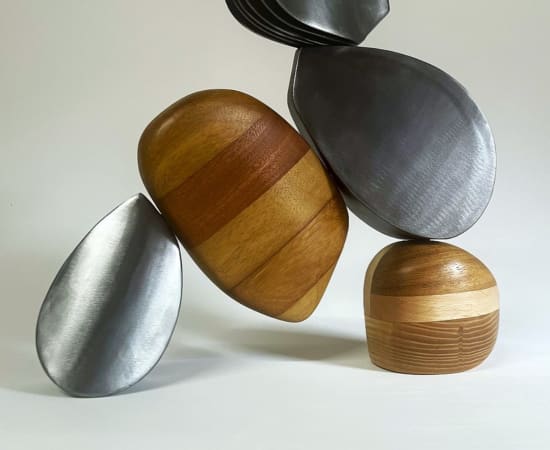Dónal Molloy-Drum Irish-Australian
Overview
"The temporal nature of life is reiterated through the balancing act of one shape encountering another."
Influenced by the vast empty plains of the Wimmera landscape he calls home, Dónal Molloy-Drum's sculptural practice looks at the relationships between volume and space, and is inspired by both the micro and macro.
Without mimicking any specific specimen found within the Australian landscape, the organic, biomorphic shapes in his sculptures appear connected to the natural world. Favouring utilitarian materials such as wood, plaster, concrete, stainless steel, and more recently the inclusion of blown glass, Molloy-Drum intentionally pushes the limits of his materials to construct his polished, abstract, lively forms.
Dónal Molloy-Drum was born and raised in Dublin, Ireland. After migrating to Australia in 1997, he now lives and works in the Wimmera region of Western Victoria. Donal studied Fine Art at the Crawford College of Art and Design in Cork in the late 1980s, majoring in sculpture. Molloy-Drum is a regular exhibitor, with work in public and private collections worldwide, including Microsoft Dublin, South Dublin County Council, the Australian Air Force, Canberra and Horsham Rural City Council. He has been a finalist in various prizes, including the Deakin Small Sculpture Prize (2023, 2021), the Swan Hill Regional Gallery Drawing and Print Prize (2020), the Yering Station Sculpture Prize (2019, 2018, 2015, 2014) the Tesselaar Sculpture Prize (2018) and was twice winner of the Yering Station Sculpture Prize People's Choice Award (2018, 2014). He has received travel grants from Creative Victoria (2022, 2020) and Regional Arts Victoria (2016, 2010) and has undertaken commissions for the City of Whitehorse, Horsham City Council and Horsham Regional Art Gallery.
"The temporal nature of life is reiterated through the balancing act of one shape encountering another. Whether supported or supporting, these forms evolve as enduring structures, often defying gravity, showing both strength and vulnerability. While highly polished, subtle, often faint, markings on the surfaces reference the passing of time, scars, stories and events connecting nature with humanity. The making process for me is about turning hard materials into soft malleable and tactile abstract forms with an organic presence, inviting the viewer to contemplate the empty spaces highlighting the curves, shadows and precarious balance of forms."
Works
Enquire









